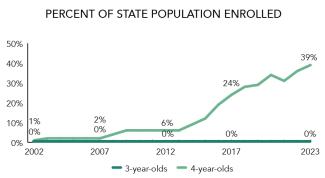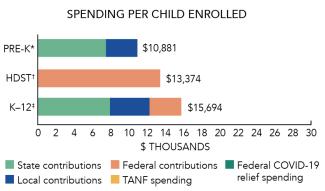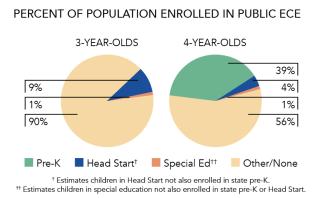
State of Preschool
Alabama
Access Rankings
Resource Rankings
Total Benchmarks Met
Overview

During the 2022-2023 school year, Alabama preschool enrolled 23,388 children, an increase of 1,449 from the prior year. State spending totaled $173,745,222, up $10,988,477 (7%), adjusted for inflation, since last year. State spending per child equaled $7,429 in 2022-2023, up $10 from 2021-2022, adjusted for inflation. Alabama met 10 of 10 quality standards benchmarks.
What's New

During the 2022-2023 school year, there was an increase in state funding of over $21 million (almost $11 million adjusted for inflation) to further expand the preschool program. Program capacity increased from 25,164 in 2021-2022 to 26,658 in 2022-2023. The Alabama Department of Early Childhood Education (ADECE) is expected to focus efforts on the state’s Turnaround Schools as designated by the state’s education report card. The Alabama Commission on Teaching and Learning as well as Governor Ivey, through a memorandum to the ADECE in 2023, are recommending increased attention and early childhood programming for the Turnaround Schools Initiative. Most of the growth in the next few years of the state’s pre-K program is expected to be in support of this effort.
Additionally, in December 2022, Alabama was awarded a federal Preschool Development Grant Birth through Five (PDG B–5) one-year planning grant for $4 million. The state is using the funding to continue strengthening Alabama’s integrated early childhood system. The funds are also being allocated to address early care and education workforce challenges and to support the inclusion of children with, or at risk of, disabilities in early care and education programming in the state.
Background
First Class Pre-K (FCPK) is a grant program administered by the Office of School Readiness within the ADECE, under the Governor’s Office. The program funds full-day preschool education for 4-year-old children in every county in a variety of settings, including public schools, private centers, Head Start programs, community organizations, faith based centers, colleges and universities, and military agencies. Using a multi-pronged approach, the ADECE Office of School Readiness has implemented evidence-based strategies and methods grounded in research to ensure that all children enrolled in FCPK have access to excellent, high-quality early learning classrooms in their communities.
Funding for FCPK is distributed from the Alabama Education Trust Fund Budget through competitive grants at three levels for pre-K programs: (1) Pre-K Excellence Grants (up to $48,300) are awarded to help programs meet quality standards and are not intended as the primary source of funding; (2) Pre-K Tiered Grants ($84,804 to $97,908 per grant) to classrooms serving a certain share of the free and reduced-price lunch eligible child population and are primary sources of pre-K funding; (3) New Classroom Grants ($120,000 per grant) cover costs of materials, equipment, furnishings, and general operating expenses in new classrooms for one year. Grantees must provide at least a 25% match to the awards locally, which can include sliding-scale fee revenue.
All teachers in FCPK classrooms must center their instructional strategies, classroom environment and activities in accordance with the Alabama First Class Framework. All FCPK classrooms are supported by a coach and monitor to support continuous improvement. Alabama requires each classroom to have a lead teacher with a minimum of a BA/BS in an early childhood-related field. Assistant teachers, required for every classroom, must have a CDA or equivalent. To support the development of a qualified workforce, high school students are encouraged to complete a CDA and can use the FCPK classrooms housed in high schools to satisfy some of the required observation hours. In 2015, the ADECE introduced policies to support salary parity for all pre-K teachers.
Alabama First Class Pre-K Program
Resources
| Total state pre-K spending | $173,745,222 |
| Local match required? | Yes |
| State Head Start spending | $5,775,801 |
| State spending per child enrolled | $7,429 |
| All reported spending per child enrolled* | $10,881 |

*Pre-K programs may receive additional funds from federal or local sources that are not included in this figure. †Head Start per-child spending includes funding only for 3- and 4-year-olds. ‡K–12 expenditures include capital spending as well as current operating expenditures.
Alabama Quality Standards Checklist
| Policy | Requirement | Benchmark | Meets Benchmark? |
|---|---|---|---|
For more information about the benchmarks, see the Executive Summary and the Roadmap to State pages. | 10benchmarks met | ||
| Early Learning & Development Standards Benchmark | Comprehensive, aligned, supported, culturally sensitive | Comprehensive, aligned, supported, culturally sensitive | |
| Curriculum Supports Benchmark | Approval process & supports | Approval process & supports | |
| Teacher Degree Benchmark | BA | BA | |
| Teacher Specialized Training Benchmark | ECE, CD, ECE SpEd | Specializing in pre-K | |
| Assistant Teacher Degree Benchmark | CDA or 9 ECE/CD credits | CDA or equivalent | |
| Staff Professional Development Benchmark | 30 hours/year (teachers); 20 hours/year (assistants); PD plans; Coaching | For teachers & assistants: At least 15 hours/year; individual PD plans; coaching | |
| Maximum Class Size Benchmark | 20 (4-year-olds) | 20 or lower | |
| Staff to Child Ratio Benchmark | 1:10 (4-year-olds) | 1:10 or better | |
| Screening & Referral Benchmark | Vision, hearing, health & more | Vision, hearing & health screenings; & referral | |
| Continuous Quality Improvement System Benchmark | Structured classroom observations; Data used for program improvement | Structured classroom observations; data used for program improvement | |
